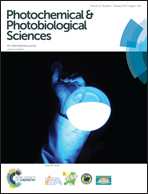Chlorin e6 fused with a cobalt-bis(dicarbollide) nanoparticle provides efficient boron delivery and photoinduced cytotoxicity in cancer cells
Abstract
Further development of boron neutron capture therapy (BNCT) requires new neutronsensitizers with improved ability to deliver 10B isotopes in cancer cells. Conjugation of boron nanoparticles with porphyrin derivatives is an attractive and recognized strategy to solve this task. We report on breakthroughs in the structural optimization of conjugates of chlorin e6 derivative with cobalt-bis(dicarbollide) nanoparticles resulting in the creation of dimethyl ester 13-carbomoylchlorin e6 [N-hexylamine-N′-ethoxyethoxy]-cobalt-bis(dicarbollide) (conjugate 1). Conjugate 1 is able to accumulate quickly and efficiently (distribution factor of 80) in cancer cells, thus delivering more than 109 boron atoms per cell when its extracellular concentration is more than 1 μmol L−1. Also 1 is an active photosensitizer and is phototoxic towards human lung adenocarcinoma A549 cells at 80 nmol L−1 (50% cell death). Photoinduced cytotoxicity of 1 is associated with lipid peroxidation, lysosome rupture and protease activity enhancement. Conjugate 1 fluoresces in the red region (670 nm), which is useful to monitor its accumulation and distribution in vivo. It is not toxic to cells without activation by neutrons or photons. Structural features that improve the functional properties of 1 are discussed. The properties of 1 warrant its preclinical evaluation as a multifunctional agent for BNCT, photodynamic therapy and fluorescent tumor diagnosis.


 Please wait while we load your content...
Please wait while we load your content...